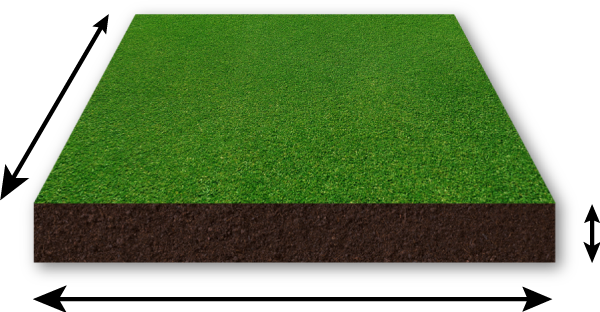Lawn Preparation & Installation.
Measuring for your lawn
When measuring up your new lawn use this simple guide to calculate how much you need.
Square and rectangle
Calculating the area for a square or rectangle is very simple. Get the overall width and the overall length of the square or rectangle, multiply the two and the result is the area of the square or rectangle.

For example, a square or rectangle
5m (wide) x 6m (length) = 30m2
Circle
To calculate the amount of turf you need in square metres (m2), measure the radius of the circle and multiply the radius (5 x 5) x 3.14 = 78.5m2

For example
(5 x 5) x 3.14 = 78.5m2
Triangles
Calculating the area for a triangle is done by getting the overall width and the overall length of the triangle, multiplying the two, and multiplying by half. The result is the area of a triangle.

For example:
3m (wide) x 6m (length) x 0.5 = 9m2
Helpful Hint!
ALWAYS remember to order extra.
For simple areas like squares and rectangles, order 5% extra. For more complex irregular areas, order 10% extra. This will allow for any slight miscalculations. It’s better to have some turf left over than to run out.
Preparing the area
Installing a new lawn yourself is both rewarding and easy. Follow these simple steps to create a healthy new lawn.
Site Preparation
· First remove all existing grass and weeds with a recommended weed killer (Glyphosate)
· Wait seven days after the first spray. Repeat if needed.
· Remove all debris from the site including rocks, building debris, dead lawn, and weeds.
· To prevent drainage issues, ensure your soil gradients are completely flat, or if you do have a slope ensure the gradient slopes away from house foundations or pathways.
Watering Systems
Now is the time to consider installing a watering system before you prepare and rake your soil.
There are two types of watering systems you could select- a traditional sprinkler-based system or a drip watering system.
An automatic watering system will give you a greener, thicker lawn and save time and water.
Soil Preparation
When preparing to lay your new lawn, good site and soil preparation ensures a good result BUT great site and soil preparation ensures a GREAT RESULT – the importance of preparing the site cannot be over-emphasised.
For optimum growth your new lawn needs four things, three of which are obtained from the soil:
· Sunlight
· Air
· Water
· Nutrients
If your soil is clay-based, apply gypsum before rotary hoeing the site. For sandy-based soils apply compost or organic matter.
Adding organic matter to a sandy profile provides more density and adding a light clay to a sandy soil profile provides more water retention.
Rotary hoe your site soil with a quality turf underlay (We recommend NITRO Underturf Soil to a minimum of 50mm-100mm deep.
Soil preparation should be completed well ahead of laying your new turf to allow for soil development.
How much soil do I need?
To calculate how much soil you need, use this simple formula below:
· Lawn Area x Soil Depth

For example:
58m2 (Lawn Area) x 0.1 (100mm Soil Depth) = 5.8m3
Raking and leveling
Prepare your soil for the new lawn by raking it to a smooth level finish.
It is recommended you also apply a turf starter with an added wetting agent to promote root development which requires encouragement in freshly laid turf.
Installation
It is essential the turf be installed as soon as it’s delivered, as the longer the lawn is stacked on the pallet the more it becomes perishable.
· First begin installing your lawn by following the longest straight line- such as a fence or paved area. You can also run a thin rope along the area to act as a border/guide.
· Lay the pieces in a brickwork fashion (stretcher bond).
· Layout lawn ensuring all joins are tightly bound together with no overlapping.
· To trim corners, use a shovel or a large sharp knife.
· If laying your new lawn on a slope- lay it across the slope.
· Once the lawn is completely installed roll the entire area with a lawn roller to improve the soil-to-lawn contact.
Post-laying care of your new turf is the most crucial part of the whole installation process. If done properly it reduces any chances of problems occurring!
Watering
Watering is an extremely important part of installing a new lawn. Water immediately as you are laying your new lawn.
For the first two weeks avoid heavy use of the lawn and water two to three times a day.
Root development can take up to six weeks depending on the type of turf so its important that this first six weeks (weather dependant) are full of a lot of TLC for your turf investment.
Once established different lawn types will have different care requirements depending on your lawn variety but it is essential during establishment that all turf types are well watered for the first 6 weeks.
Post-installation care
Mowing
You can start mowing your new lawn as soon as the turf is firmly rooted.
Generally, new roots, depending on the season can take between 2 to 4 weeks to firmly establish. In cooler months this could be slightly longer.
Once your newly laid turf has established a root system into the soil you can mow.
Don’t remove anything more than 1/3 of the leaf length so ensure your mower deck is on high.
Once established mow your lawn in line with the varieties requirements.
Fertilising
After installation, it is important to use a slow-release fertiliser. We recommend NITRO “Boost” for lawns.
Once established, it’s important you fertilise in each season:
· Early spring
· Early summer
· Late summer
Watering your new lawn
New lawns require special lawn care practices during their establishment phase, with the highest attention paid to the amount of water being applied.
The high-water requirements for new lawn is due to the fact that the lawn has no root system attached to the soil.
It’s the lack of any root system, or root system within the soil which means the lawn cannot receive any water from the soil.
It’s for this reason that new lawns will need to be kept wet at all times during establishment.
Without the added water being applied, the new turf would, otherwise very quickly dry out and die.
Judging how much water to apply to new lawns
The amount of water that will need to be applied to a new lawn will change depending on the conditions where the lawn was laid.
The principle involved will always be the same- which is to keep the new lawn wet at all times.
Rule of thumb- new lawns need to be watered every day and sometimes more than once a day to keep soil moist.
Once the lawn is established, revert to watering as required.
The best time to water your lawn is early mornings between 4 am-10 am.
Early morning lawn watering is best because there is less wind to blow the water away and less sunlight to evaporate it. It also discourages disease by giving the lawn the rest of the day to dry out.
Installing in:
Dry hot weather
New lawns which are laid during the heat of summer require the greatest amount of water which may be as often as 4 times a day in the first week.
Warm Weather
Warmer weather in the high 20 degrees to 30 degrees will require a new lawn to be watered a little less frequently, which may be around 3 times a day.
Cooler Weather
Cool-weather requires less water again and may be as low as 1-2 waterings a day.
Rainy Weather
During cool rainy weather, the new lawn may require less watering.
Monitor the new lawn at all times
An exact lawn watering schedule for new lawns will always be a judgment call while following the golden rule of keeping the lawn wet at all times.
The lawn should be monitored to ensure the ongoing health of the new lawn.
The lawn should remain green and growing, if it begins to brown off at any time then the lawn may require more watering than its receiving.
So, it is simply a case of increasing watering times or frequencies.
Reducing your watering
The highest requirement for watering will be during the establishment phase.
Watering can then be reduced as the following week's progress and the root system of the lawn becomes more established.
Remember if you are in a local government area where water restrictions apply please check details with the appropriate water authority.














